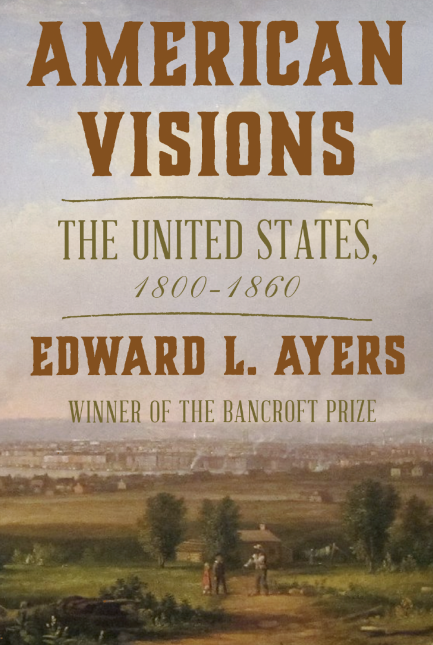American Visions: The United States, 1800-1860
- By Edward L. Ayers
- W.W. Norton & Company
- 368 pp.
- Reviewed by Paula Tarnapol Whitacre
- November 20, 2023
A broad, beneficent examination of the six decades before the Civil War.

Edward L. Ayers has written thoughtfully on the American Civil War for years, most notably through his books and articles on the “Valley of the Shadow,” the communities just north and south of the Mason-Dixon Line in Franklin County, Pennsylvania, and Augusta County, Virginia. In American Visions, he pulls back to consider the broader swirl of trends, ideas, and events that occurred in the six decades before the war began.
It is both a general and a generous look. By general, I mean that Ayers includes dozens of topics in about 300 pages. Famous and obscure, heroic and evil, “each person in this diverse cast articulated a vision, some in the language of religion, art, and literature, others in politics and power, and others in commerce and invention.” Some, such as Herman Melville, are far better known today than back then, while others were “famous in their time but subsequently forgotten.”
Amid the wide array of topics, Ayers discusses abortion and birth control, race as a pseudo-scientific construct, the proliferation of firearms after the Mexican War, and much more.
A data point that sticks with me still: From 1836 to 1838, 40 percent of the entire federal budget went “to the dispossession of Native people, mainly to government contractors who grew rich in the suffering.”
Through his nine main chapters, Ayers carves out time periods that range from two to almost 30 years and titles each chapter with a defining characteristic (for example, “Reflections” for the period from 1836 to 1848, and “Boundaries” from 1840 to 1845). Some flow more logically than others, and sometimes one section abruptly pivots to the next (e.g., moving from the discovery of oil in Pennsylvania to Walt Whitman’s Leaves of Grass). I would’ve appreciated an explanation in the preface about how he chose these periods (which sometimes overlap and are at other times sequential) and thematic titles.
By a generous look, I refer to the author’s belief that “we can choose to remember a fuller American history, one that is more truly patriotic, one that evokes the nation’s highest ideas of equality and mutual respect in the face of the nation’s failings.” He notes that not all American visions were (nor are) pure, particularly whites’ attitudes about and actions against Black and Indigenous peoples. Describing himself as an optimist, however, Ayers looks for a compassionate legacy from the period:
“The early appearance of those struggles revealed, during the deepest darkness in American history, that a concern for rights of some can grow into respect for the rights and dignity of all. The language of empathy, inclusion, and mutual understanding forged in the first decades of American history, like the language of exclusion and possession forged at the same time, created a vocabulary of national self-reflection that is resonant still.”
More broadly inclusive visions that developed in this period eventually caught on, he asserts, even when they began very small and were squashed at the time. As a more pessimistic person than Ayers, I fear that the period’s uglier visions are now ascending.
Although Ayers does not aim to write biographies, a few people seem to have gotten off easy in American Visions. For example, he lauds Catherine Beecher (sister of Harriet Beecher Stowe) for organizing her students to petition against the U.S. government’s removal of Cherokee and other Native people from the Southeast, but does not write about her opposition to abolition and the early women’s rights movement. He describes the literary visions of Nathanial Hawthorne but not his devotion to (and political patronage from) Franklin Pierce, one of the nation’s weakest presidents. He acknowledges that John James Audubon was an enslaver and shady businessman, but not the discussion today about whether one of the largest environmental groups in America should be named for this man.
Ayers also highlights many people who deserve wider recognition. Among them are William Apess (a Pequot writer and preacher who “confronted his readers with the words of the religion they shared”); Maria Stewart (a Black orator and writer who, as a widow, “spoke with a freedom denied married women or women who had never married”); and Susan Fenimore Cooper (a white nature writer who “portrayed subtle changes and looming dangers in the New York landscape”).
When Barack Obama awarded Ayers a National Humanities Medal in 2013, the president praised Ayers’ “commitment to making our history as widely available and accessible as possible.” An early advocate of the digital humanities, Ayers made thousands of letters, maps, and other materials available online to accompany his “Valley of the Shadow” books. A more recent project, for which he is executive director, is New American History, which “explores America’s past, harnessing the power of digital media, curiosity, and inquiry.”
American Visions aligns well with this mission, and teachers looking for ways to help their students understand the relevance of history may be its ideal readers. The book is rosy-hued in parts, but Ayers offers in it a lens through which we as a nation can see where we’ve been and where we’re going.
Paula Tarnapol Whitacre writes about history, with a focus on 19th-century social history. She is currently working on a book about the Civil War and Reconstruction as experienced in Alexandria, Virginia.

